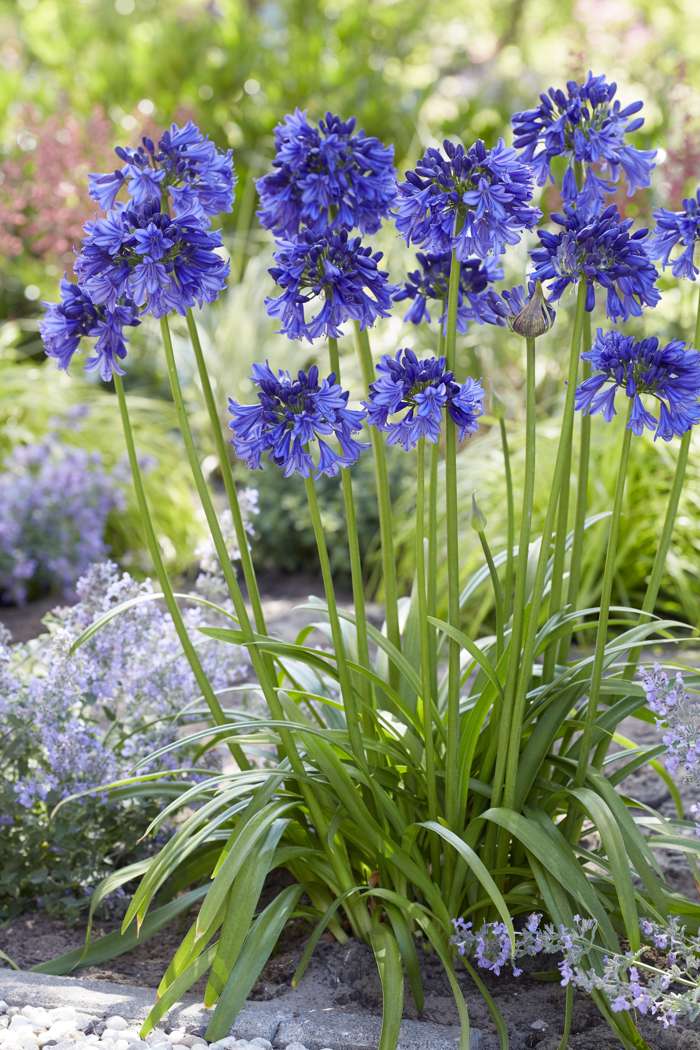Agapanthus Growing Conditions: Dirt, Sunshine, and Watering
Wiki Article
Releasing the Secret to Successful Agapanthus Farming: Idea for a Flourishing Yard
In the realm of horticulture, cultivating agapanthus efficiently requires a critical technique that includes numerous aspects of plant care. By comprehending the nuances of agapanthus farming, one can develop a setting where these plants grow and flower abundantly.Growing Agapanthus: Best Practices
When planting Agapanthus, correct soil prep work is crucial for guaranteeing effective growth and growth of these beautiful flowers. Agapanthus, generally known as Lily of the Nile or African lily, prospers in well-draining dirt with a somewhat acidic to neutral pH level - Agapanthus. Prior to planting, it is vital to modify hefty clay dirts with natural matter such as compost or peat moss to enhance drainage and offer essential nutrients for the plantsTo plant Agapanthus, choose a location that obtains complete sunshine to partial shade, as this will advertise healthy and balanced development and abundant flowering. Dig a hole twice the diameter of the plant's root ball and place the Agapanthus at the same depth it was previously growing. Delicately backfill the hole with soil, weighing down firmly to remove any kind of air pockets around the origins.
Water the freshly planted Agapanthus thoroughly and remain to maintain the dirt evenly moist, particularly throughout the plant's energetic expanding season. Agapanthus. Applying a well balanced fertilizer once a month can additionally support the plant's development and flowering. By complying with these finest methods for planting Agapanthus, you can produce a spectacular screen of these exciting blossoms in your yard
Suitable Dirt Issues for Agapanthus
For ideal development and growing success of Agapanthus plants, ensuring the dirt conditions are ideal is critical. Agapanthus chooses dirt that is rich in nutrients, so including a well balanced plant food during the growing period can promote healthy and balanced growth and lively blooms.
Watering and Feeding Tips
To make certain healthy and balanced growth and vibrant blooms, correct watering and feeding strategies are important for effective Agapanthus growing. Agapanthus plants profit from regular watering, particularly throughout the expanding season.When it concerns fertilizing Agapanthus, a well balanced plant food with equivalent parts nitrogen, phosphorus, and potassium can be used in the spring to advertise healthy growth and flowering. Slow-release plant foods are perfect for offering nutrients progressively over a prolonged period. Prevent over-fertilizing, as this can result in too much foliage development at the cost of blooms.
In addition, incorporating natural matter like garden compost into the soil can boost nutrient levels and enhance dirt structure, assisting in the total health and wellness of the Agapanthus plants. By following these watering and feeding suggestions, garden enthusiasts can ensure their Agapanthus plants prosper and produce spectacular displays of blossoms.
Trimming and Deadheading Strategies
Correct trimming and deadheading methods play a crucial function in keeping the health and looks of Agapanthus plants, matching the essential methods of watering and feeding for successful growing. Pruning Agapanthus includes getting rid of spent blossom heads, dead or yellowing fallen leaves, and total shaping of the plant to promote far better growth. Deadheading, the procedure of eliminating faded flowers, not only improves the plant's appearance however likewise motivates more flowering.When deadheading Agapanthus, it is a good idea to clip off the flower stem at the base using sharp, tidy shears. This process redirects the plant's energy from seed production back right into origin and foliage development, advertising a healthier and a lot more durable plant. Regular deadheading can expand the growing duration of Agapanthus and avoid self-seeding, which can result in overcrowding.
In terms of pruning, Agapanthus typically benefits from a light trim after blossoming to clean up the plant and motivate fresh growth. Reducing the invested blossom stems and eliminating any dead or broken foliage helps keep the plant's vitality the original source and general look. However, it is vital to prevent cutting into the crown of the plant, as this can weaken its wellness.

Protecting Agapanthus From Pests and Diseases
Implementing reliable insect and disease management methods is important to safeguarding the health and wellness and vitality of Agapanthus plants in farming. Agapanthus are generally durable plants, however they can still drop sufferer to numerous bugs and illness if not properly cared for. One usual insect that affects Agapanthus is the Agapanthus borer, a caterpillar that passages right into the plant, triggering damage to the blossoms and leaves. To avoid infestations, normal evaluation of the plants is vital. If borers are spotted, they can be manually removed, or insecticidal soap can be utilized as a control action.In enhancement to parasites, Agapanthus are susceptible to illness such as root rot and fungal leaf areas. By staying alert and addressing parasite and condition issues quickly, gardeners can help their Agapanthus thrive and flourish.

Conclusion
To conclude, effective cultivation of agapanthus calls for appropriate planting strategies, optimal dirt conditions, appropriate watering and feeding, routine trimming and deadheading, and protection from conditions and parasites. By following these Go Here ideas and tricks, garden enthusiasts can ensure a growing yard loaded with lovely agapanthus blossoms. Agapanthus. Keep in mind to keep constant treatment and interest to information to promote the wellness and longevity of these sensational plantsWhen planting Agapanthus, appropriate dirt prep work is essential for making certain effective growth and advancement of these lovely blossoms.Water the recently planted Agapanthus completely and continue to keep the soil uniformly damp, specifically throughout the plant's energetic expanding period.For ideal development and flowering success of Agapanthus plants, ensuring the soil conditions are perfect is important. When planting or transplanting Agapanthus, ensure the soil is well-prepared to supply the necessary foundation for the plants to establish themselves efficiently. One usual parasite that influences Agapanthus is the Agapanthus borer, a caterpillar that passages into why not try here the plant, triggering damages to the blossoms and fallen leaves.
Report this wiki page